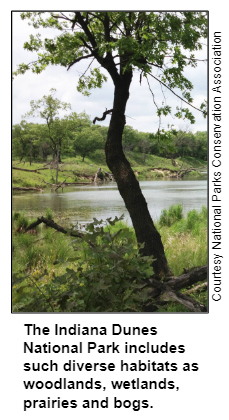Jun 28, 2019
(June 22, 2019 ) Earlier this year, the Indiana Dunes made national news with the announcement that the distinctive shoreline on Lake Michigan would be a new national park, the first one in the state.
But does its designation as Indiana Dunes National Park - rather than the former Indiana Dunes National Lakeshore - make a substantive difference?

During our show, two guests join Nelson by phone from their Porter County offices at the Dunes:
- Bruce Rowe, public information officer for Indiana Dunes.
- And Dustin Ritchea, promotions director for Indiana Dunes Tourism.
In an interview with the Indianapolis Star when the national park designation was announced in February, Dustin described the Indiana Dunes as one of the most biodiverse areas of North America - with more plant and animal species than Hawaii. In addition to sand dunes, Indiana Dunes includes woodlands, wetlands, prairies and bogs.
During the early 1900s, Chicago-based painter Frank Dudley became captivated by the dunes. He crusaded to have them preserved even as steel plants and other industrial development was occurring nearby in northwest Indiana. Carl Sandburg, who lived in Chicago, came to the dunes to write some of his poetry; he once called the dunes "eternity's signature."
Proposals to designate the Indiana Dunes as a national park started more than 100 years ago. In 1916, the first director of the National Park Service initially suggested the idea, according to The Indianapolis Star. The Indiana Dunes State Park was opened in 1926.

Although this is our first show devoted exclusively to the Indiana Dunes, aspects of their heritage have come up during several previous Hoosier History Live programs. They have included:
- A show in 2018 about the House of Tomorrow and other showplace homes from the 1933 Chicago World's Fair. They were brought by barge to the Indiana Dunes resort town of Beverly Shores after the closing of the fair.
- And a show about bygone natural landmarks in 2016 that explored the Hoosier Slide, the tallest dune. It had disappeared by 1920 after its sand was hauled away for decades for use in commercial endeavors, particularly the glass-making industry.
According to Indiana Dunes Tourism, more than 3.6 million visitors came to the Dunes last year, putting the area on a par with Mount Rushmore's visitation.
Because of its biodiversity, Indiana Dunes is promoted as "one of the best spots in the Midwest for bird watching." More than 1,000 species of plant life also can be found there.
Consideration of national park designation for the Indiana Dunes dates back more than 100 years, according to an article in the June issue of Indianapolis Monthly. In 1916, Stephen Mather, the first director of the National Park Service, suggested the designation. The country's focus on World War I, however, meant the push was tabled and the proposal was essentially forgotten.
In total, the Indiana Dunes have 15 miles of white sand beaches on Lake Michigan. The Hoosier Slide, at about 200 feet tall, was the largest dune before it was destroyed by sand mining.